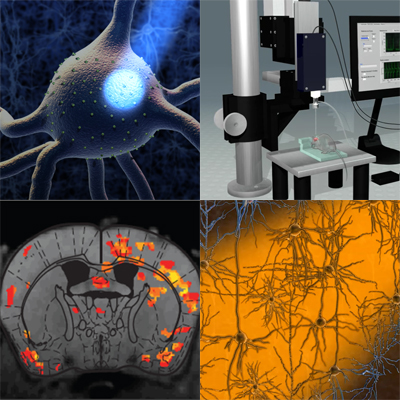Principles of Neuroengineering
[Class Content] [Fall 2019] [Fall 2018] [Fall 2017] [Fall 2014] [Fall 2013] [Fall 2012] [Fall 2011] [Fall 2010] [Fall 2009] [Fall 2008] [Fall 2007]

MIT Course Numbers: 9.422 ~ 20.452 ~ MAS.881
Instructor: E.S. Boyden
Units: 3-0-9 Units
Time: Tuesdays and Thursdays, 10:30AM-12PM
Place: E14-493
Description
Covers how to innovate technologies for brain analysis and engineering, for accelerating the basic understanding of the brain, and leading to new therapeutic insight and inventions. Focuses on using physical, chemical and biological principles to understand technology design criteria governing ability to observe and alter brain structure and function. Topics include optogenetics, noninvasive brain imaging and stimulation, nanotechnologies, stem cells and tissue engineering, and advanced molecular and structural imaging technologies. Design projects by students.
Schedule
Part I. Towards ground-truth understanding of the brain. Knowns (principles, building blocks, functions) and unknowns.
9/10, Overview of the class. Introductions.
9/15, Circuit elements of the nervous system. Neurons, glia, blood vessels. Channels, receptors. Genes, cell types. Modalities of signaling (ionic, gap junctional, ephaptic, synaptic/chemical, second messenger, diffusible, etc.). Analog vs. digital signaling. New mechanisms.
9/17, Macroscopic circuits. Brain regions and connectivity, large-scale dynamics. How these past conclusions were influenced by past technologies, and what is unknown or uncertain. Tiling trees and other strategies for thinking.
9/22, Microscopic circuits. Cell type-specific connectivity, connectomics, gliocircuits. How these past conclusions were influenced by past technologies, and what is unknown or uncertain.
9/24, Principles of designing tools. Top-down vs. bottom-up design approaches, architecting, tools for science vs. for the clinic, ease of use, democratization vs. observatories, assumption-proofing.
Part II. Technologies for mapping and measurement: molecular, anatomical, and dynamical observation and readout.
9/29, Large-scale mapping and measurement. PET, photoacoustic imaging, MEG, EEG, fMRI, infrared imaging. Physical principles of large-scale brain interfacing.
10/8, Fine-scale mapping and measurement. Electrodes, nanoprobes, nanoparticles, optical imaging and microscopy, endoscopy, multiphoton microscopy, electron microscopy.
10/15, Midterm presentations.
Part III. Technologies for controlling and constructing: molecular, anatomical, and dynamical control and building.
10/22, Large-scale control. Magnetic, electrical, ultrasonic, pharmacological/pharmacogenetic, thermal.
10/27, Fine-scale control. DBS, infrared optical stimulation, optogenetics, nanoparticle-mediated control, uncaging, signaling control.
11/3, Circuit assembly. Development, 3-D brain building, tissue engineering, stem cells, gene therapy and viral/trangenic technologies, extracellular matrix.
11/5, Building blocks of future tools. Barcoding, quantum-measurement nanoparticles, DNA origami, exosomes, prions, post-transcriptional/translational modifications.
11/12, Further principles of design and building blocks of tools.
Part IV. Conclusion.
11/24, Final project presentations, part I.
12/3, Final project presentations, part II.